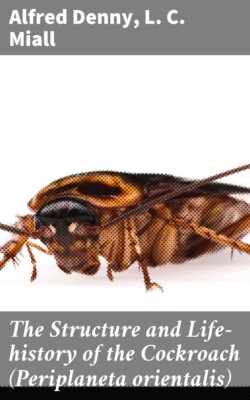Читать книгу The Structure and Life-history of the Cockroach (Periplaneta orientalis) - L. C. Miall - Страница 11
Characters of Arthropoda.
ОглавлениеArthropoda are in general readily distinguished from other animals by their jointed body and limbs. In many Annelids the body is ringed, and each segment bears a pair of appendages, but these appendages are soft, and never articulated. The integument of an Arthropod is stiffened by a deposit of the tough, elastic substance known as Chitin, which resembles horn in appearance, though very different in its chemical composition. In marine Arthropoda, as well as in many Myriopoda and Insects, additional firmness may be gained by the incorporation of carbonate and phosphate of lime with the chitin. However rigid the integument may be, it is rendered compatible with energetic movements by its unequal thickening. Along defined, usually transverse lines it remains thin, the chitinous layer, though perfectly continuous, becoming extremely flexible, and allowing a certain amount of deflection or retraction (fig. 1). The joints of the trunk and limbs may thus resemble stiff tubes. Muscles are attached to their inner surface, and are therefore enclosed by the system of levers upon which they act (fig. 2B). In Vertebrate animals, on the contrary, which possess a true internal skeleton, the muscles clothe the levers (bones) to which they are attached (fig. 2A). The whole outer surface of an Arthropod, including the eyes, auditory membrane (if there is one), and surface-hairs, is chitinised. Chitin may also stiffen the larger tendons, internal ridges and partitions, and the lining membrane of extensive internal cavities, such as the alimentary canal, and the air-tubes of Insects.
Fig. 1.—Diagram of Arthropod limb extended, retracted, and flexed. Graber has given a similar figure (Insekten, fig. 8*).
Fig. 2.—Vertebrate and Arthropod joints. A, Vertebrate joint, the skeleton clothed with muscles. B, Arthropod joint, the skeleton enclosing the muscles.
In most Arthropoda the body is provided with many appendages. In Crustacea there are often twenty pairs, but some Myriopoda have not far from two hundred pairs. Some of these may be converted to very peculiar functions; in particular, several pairs adjacent to the mouth are usually appropriated to mastication. One or more pairs of appendages are often transformed into antennæ.
The relative position of the chief organs of the body, viz.:—heart, nerve-cord, and alimentary canal, is constant in Arthropoda. The heart is dorsal, the nerve-cord ventral, the alimentary canal intermediate. (See fig. 3.) The œsophagus passes between the connectives of the nerve-cord. Not a few other animals, such as Annelids and Mollusca, exhibit the same arrangement.
Arthropoda are not known to be ciliated in any part of the body, or in any stage of growth. Another histological peculiarity, not quite so universal, is the striation of the muscular fibres throughout the body. In many Invertebrates there are no striated muscles at all, while in Vertebrates only voluntary muscles, as a rule, are striated.
The circulatory organs of Arthropoda vary greatly in plan and degree of complication, but there is never a completely closed circulation.
The development of Arthropoda may be accompanied by striking metamorphosis, e.g., in many marine Crustacea, but, as in other animals, the terrestrial and fluviatile forms usually develop directly. Even in Insects, which appear to contradict this rule flatly, the exception is more apparent than real. The Insect emerges from the egg as a fully formed larva, and so far its development is direct. It is the full-grown larva, however, which corresponds most nearly to the adult Myriopod, while the pupa and imago are stages peculiar to the Insect. It is not by any process of embryonic development, but by a secondary metamorphosis of the adult that the Insect acquires the power of flight necessary for the deposit of eggs in a new site.
Fig. 3.—Longitudinal section of Female Cockroach, to show the position of the principal organs. Oe, œsophagus; S.gl, salivary gland; S.r, salivary reservoir; Cr, crop; G, gizzard; St, chylific stomach; R, rectum; Ht, heart; N.C, nerve-cord. × 7.
